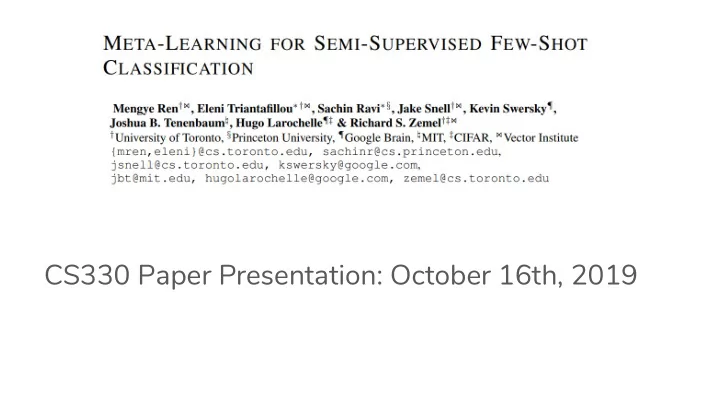

CS330 Paper Presentation: October 16th, 2019
Supervised Classification
Semi-Supervised Classification: More realistic dataset Labelled Unlabelled
Semi-Supervised Classification Most “biologically plausible” learning regime
A familiar problem: ? Few-shot, multi-task learning: Generalize to unseen classes
A new twist on a familiar problem: ?
How can we leverage unlabelled data for few-shot classification?
Unlabelled data may come from the support set or not (distractors)
Strategy: As we can now appreciate, there are a number of possible ways to approach the original problem. To name a few: Siamese Networks (Koch et al, 2015) ● Matching Networks (Vinyals et al., 2016) ● Prototypical Networks (Snell et al., 2017) ● Weight initialization / Update step learning (Ravi et al., 2017, Finn et al., 2017) ● MANN (Santoro et al., 2016) ● Temporal convolutions (Mishra et al., 2017) ● All are reasonable starting points for semi-supervised few-shot classification problem!
Prototypical Networks (Snell et al., 2017) Very simple inductive bias!
Prototypical Networks (Snell et al., 2017) For each class, compute prototype Embedding is generated via a simple convnet: Pixels - 64 [3x3] Filters - Batchnorm - ReLU - [2x2] MaxPool = 64D Vector https://jasonyzhang.com/convnet/
Prototypical Networks (Snell et al., 2017) For each class, compute prototype Softmax distribution of distances to prototypes for new image Compute loss
Prototypical Networks (Snell et al., 2017) For each class, compute prototype Softmax distribution of distances to prototypes for new image Compute loss Very simple inductive bias: Reduces to a linear model with Euclidean distance
Support Strategy for semi-supervised: Unlabelled Test Refine Prototypes centers with unlabelled data.
Strategy for semi-supervised: 1. Start with labelled prototypes 2. Give each unlabelled input a partial assignment to each cluster 3. Incorporate unlabelled examples into original prototype
Prototypical networks with Soft k -means Unlabelled support set Partial Assignment
Prototypical networks with Soft k -means What about distractor classes?
Prototypical networks with Soft k -means w/ Distractor Cluster Add a buffering prototype at the origin to “capture the distractors”
Prototypical networks with Soft k -means w/ Distractor Cluster Add a buffering prototype at the origin to “capture the distractors” Assumption: Distractors all come from one class!
Soft k-means + Masking Network 1. Distance 2. Compute mask with small network
Soft k-means + Masking Network differentiable
Soft k-means + Masking In practice, MLP is a dense layer with 20 hidden units (tanh nonlinearity)
Datasets Omniglot ● mini ImageNet (600 images from 100 classes) ●
Hierarchical Datasets Omniglot tiered ImageNet
tiered Imagenet miniImageNet: Test - electric guitar Train - acoustic guitar tierediImageNet: Test - musical instruments Train - farming equipment
Datasets Omniglot ● mini ImageNet (600 images from 100 classes) ● tiered ImageNet (34 broad categories, each containing 10 to 30 classes) ● 10% goes to labeled splits 90% goes to unlabelled classes and distractors* *40/60 for miniImageNet
Datasets Omniglot ● mini ImageNet (600 images from 100 classes) ● tiered ImageNet (34 broad categories, each containing 10 to 30 classes) ● Much less labelled data than standard few-shot approaches!!! 10% goes to labeled splits 90% goes to unlabelled classes and distractors* *40/60 for miniImageNet
Datasets N : Classes K : Labelled samples from each class M : Unlabelled samples from N classes H : Distractors (Unlabelled sample from classes other than N) H = N = 5 M=5 for training & M=20 for testing
Baseline Models 1. 1. Vanilla Protonet
Baseline Models 1. 2. 1. Vanilla Protonet 2. Vanilla Protonet + one step of Soft k-means refinement at test only (supervised embedding)
Results: Omniglot
Results: miniImageNet
Results: tieredImageNet
Results: Other Baselines
Results Models trained with M=5 During meta-test: vary amount of unlabelled examples
Results
Conclusions: 1. Achieve state of the art performance over logical baselines on 3 datasets
Conclusions: 1. Achieve state of the art performance over logical baselines on 3 datasets 2. K-means Masked models perform best with distractors
Conclusions: 1. Achieve state of the art performance over logical baselines on 3 datasets 2. K-means Masked models perform best with distractors 3. Novel: models extrapolate to increases in amount of labelled data
Conclusions: 1. Achieve state of the art performance over logical baselines on 3 datasets 2. K-means Masked models perform best with distractors 3. Novel: models extrapolate to increases in amount of labelled data 4. New dataset: tiered ImageNet
Critiques: 1. Results are convincing, but the work is actually a relatively straightforward application of (a) Protonets and (b) k-means clustering 2. Model Choice: protonets are very simple. It’s not clear what they gained by the simple inductive bias 3. Presented approach does not generalize well beyond classification problems
Future directions: extension to unsupervised learning I would be really interested in withholding labels alltogether Can the model learn how many classes there are? … and correctly classify them?
Future directions: extension to unsupervised learning
Thank you!
Supplemental: Accounting for Intra-Cluster Distance
Recommend
More recommend